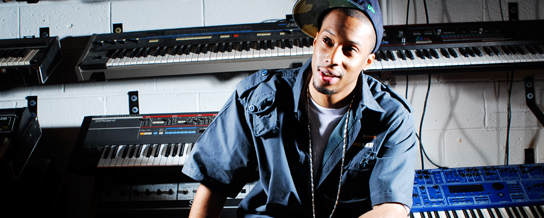In The Studio: Black Milk
With his breakthrough 2007 sophomore album, Popular Demand, rapper/producer Black Milk proudly repped the Detroit […]

With his breakthrough 2007 sophomore album, Popular Demand, rapper/producer Black Milk proudly repped the Detroit hip-hop tradition with his dirty drums and soulful samples. But his latest LP, Tronic, sees the man born Curtis Cross looking further into the city’s history for inspiration. On Tronic, Black Milk utilizes elements of the D’s electronic dance movement, adding techno-inspired synth lines and other unexpected instrumentation to his MPC-derived loops. Recorded at his home and at two other studios in the area (Studio One and Disc Studios), Tronic was no overnight effort. We talked to the Detroit native about his new approach, new gear, and how this opuswas far from a one-man show.
XLR8R: On the cover of Popular Demand, you’re clutching the MPC, but on Tronic, you’re surrounded by synths. What’s the literal significance of that transition?
Black Milk: Yeah, I gotta stop doing album covers [laughs]. I don’t know why I keep doing that, but it ended up being like that two times. But yeah, I did use more keyboards this time—you listen to the album and you hear more synth-bass and just keys all throughout. It’s not just a straight sample and drums, you know? So it kinda matches the music.
What kind of synths did you draw from the most?
This keyboard called the R2—it’s a Korg. I use that a lot. I also used the MicroKorg keyboard a little bit, but it was mostly the R2.
I notice you’ve still got that real stutter-step rhythm [on Tronic], but you introduced new melodies. Can you talk about that whole process and also drawing influence from different Detroit sounds (like house music)?
The house and the techno, that kinda comes from the D—that electronic sound—so there was a little bit of influence. I knew I had to throw some of those records on and try to find similar sounds to make my own sound. So that was some of the process, and just listening to different types of music from all genres—not just electronic or futuristic, abstract, whatever you wanna call it. It’s all styles of music, from funk to soul. That was the process. [I was] trying to create a project where I could show as much versatility as possible without sounding like I’m doing too much.
How much work did you actually do at home just on the MPC? At what point did you actually bring it to the other studios?
I’d say every track started at home on the MPC, chopping up the vinyl. And then after that, after I got the main beat and decided if I wanted to use that track for the album or not, that’s when I took it to the studio and I finished it up. But every track on there started at the crib.
As far as live players, who is on this album?
A couple cats out the D. There was a lot of musicians that were doing their thing that I ran into. One of the horn players’ names is Sam Bobe; he actually played the [trumpet] on “Give the Drummer Sum.” And this other guy, John Arnold, he was on guitars. Those are a few guys that I worked with and I brought in a couple trombone players, brought in some key players, [like] Colin Monroe. He produces himself so he produced the track “Without U”; [it ’s] real synth-heavy but still melodic. Generally I was just trying to get ideas from everyone. I didn’t want the album just to be all me trying to create so that’s why I brought other ears and other ideas to the table.
When I spoke with you last year, you said you wanted to also start playing live stuff yourself, like drums. How has that been going for you?
I played keys on the album but I when I get some time I want to actually sit down and learn music theory and really master playing keys. That’s one of my next focuses. I can play a little bit but I would never call myself a keyboard player and try to get on stage and actually play with a band. I play a little bit of drums, but I haven’t mastered that neither, so the only thing I have mastered is the MPC and the beats. Like I said, I dibble and dabble in other little things, too. But once I get some time, one of my goals is to try to learn a couple instruments and try to incorporate them into my producing process.
MP3: “Bounce”

